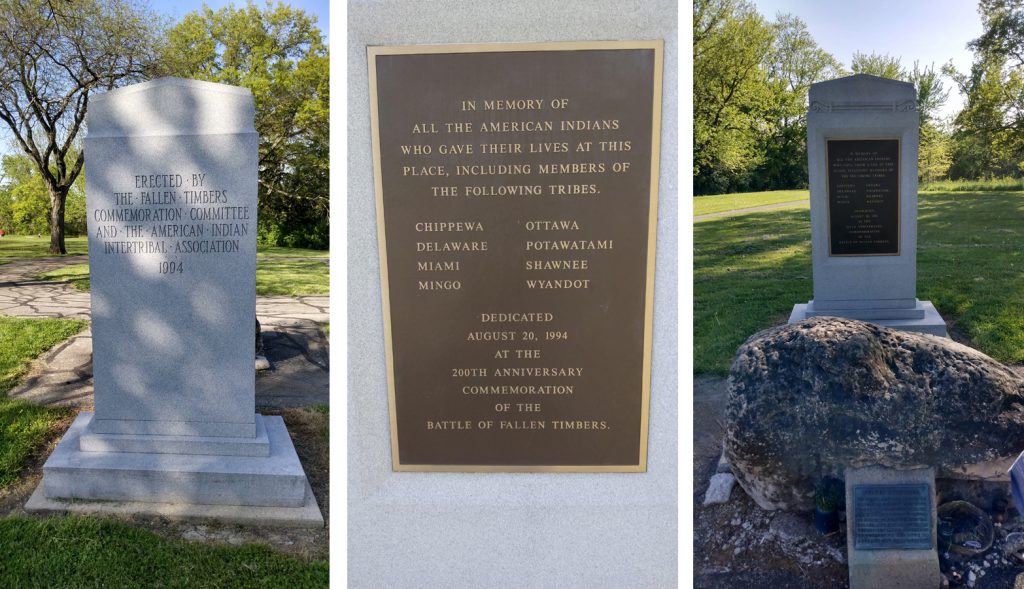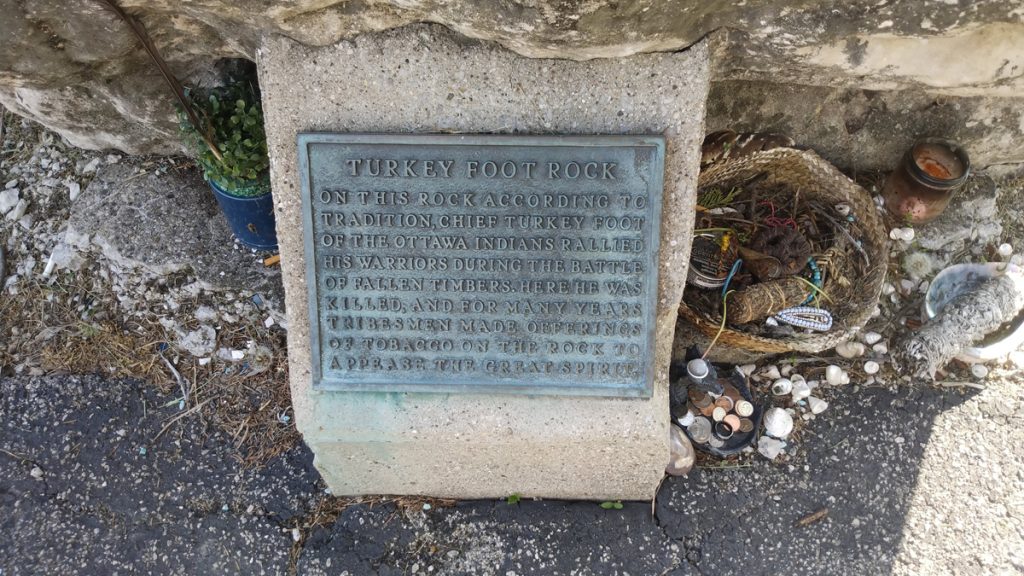Northern Ohio has a surprising number of historical sites related to the American Revolution and beyond. Travelers or residents have their choice between the Historic Fort Steuben in Steubenville, the General Moses Cleaveland statue in Cleveland, Ohio, or the Moravian missionary village massacre site at Gnadenhutten, to name a few. Maumee, Ohio, just outside of Toledo, holds what would probably be one of the more important sites: the Battle of Fallen Timbers Monument.
The Battle of Fallen Timbers is represented in multiple sites. The Fallen Timbers Battlefield and Fort Miamis National Historic Site, commissioned in 1995, holds both the remains of Fort Miamis (a fortification held by the British at the time of the battle) and the Fallen Timbers Battlefield. The Fallen Timbers Battlefield is over 180 acres of largely undisturbed land that was not considered to be part of the event’s history for decades but is now recognized as the battlefield itself. There is also a state memorial, less than a mile south of the battlefield overlooking the Maumee River, that is often referred to as the Fallen Timbers Monument. This article focuses on the state memorial site and the monuments to General Anthony Wayne and others located at the state memorial.
The memorial is conveniently located off Interstate 475 and holds three separate monuments. The main attraction is undoubtedly the statue of General Anthony Wayne, flanked by a Native American scout and a frontiersman. The monument is twenty-five feet tall. The ten-foot-tall statues are mounted on a fifteen-foot pedestal of marble, adorned with plaques detailing some of the history and context of the site and namesake battle. This monument is meant to honor Wayne’s leadership at this decisive action, often heralded as the American Revolution’s final battle.[1] Wayne led roughly 3,000 soldiers, both regulars and militia, under orders from then-president George Washington, to the Maumee River at the mouth of Lake Erie where Shawnee Chief Blue Jacket was waiting.[2] The goal was to further western expansion, taking the Northwest Territories from the British who still claimed them and the Indian tribes that still lived on them.
August 20, 1794, the day of the battle, began with rain, convincing the Native Americans and their British allies that no military engagements would occur. As such, many of the Native tribes temporarily retired to Fort Miamis to rest and eat, as they had participated in a two-day fast to prepare for battle. While the Native Americans were breaking their fast, Wayne and the soldiers under his command pressed forward, being led by a detachment of Kentucky militia.[3] Having spotted the advancing US Army troops, the Potawatomi and Odawa tribes, led by Egushawa and Little Otter, respectively, fired the first volley of the Battle of Fallen Timbers, scattering the Kentuckians.
Soon after, the Native Americans and their allies rushed the soldiers, engaging them in melee combat, though they were eventually halted by Lt. Col. Jean Francois Hamtramck’s sub-legions once they reformed their lines of defense.[4] Wayne quickly ordered artillery to the forefront of the detachment, which fired countless rounds of grapeshot into the Native Americans and British lines, leading to their disorganization and retreat. Wayne’s troops then advanced, chasing the Indians back to Fort Miamis. There were several attempts at regrouping the allied tribes, including by Odawa Chief Turkey Foot (who was promptly shot and killed), but none were successful, as the US army, especially the mounted dragoons, advanced quickly over the open terrain and overcame the unmounted defenders of Fort Miamis.[5] In all, the Battle of Fallen Timbers was a quick event, lasting a little over an hour.
The statues of Wayne and his comrades face south by southeast and overlook the Maumee River and floodplain. It was originally thought that this area was the site of the Battle of Fallen Timbers, until archaeological digs in the 1980s and 1990s convinced historians and visitors that the battlefield rested slightly north. Regardless, this set of memorials is well worth the visit.[6]
While the main memorial highlights the victory of the American soldiers at Fallen Timbers, what is not forgotten are the fallen soldiers on both sides of the engagement. To the Wayne Memorial’s north is a marble slab which honors the US Army’s and Kentucky Volunteers’ thirty-three fallen sons. Most soldiers are named, though several men from each military group remain unidentified. In addition to their names, the monument gives the soldiers’ ranks and companies.


The third memorial also flanks the main statue of Wayne and company. This memorial focuses on the Indians who died at the Battle of Fallen Timbers. As a force of confederated tribes, European settlers, and a company of British militia from Lower Canada, all attempting to repel western expansion and settlement, the force numbered nearly 1,300, roughly one-third the size of the contingent that Wayne commanded.[7] Though estimates guess that only thirty to forty warriors died on the battlefield on August 20, 1794, the aftermath of the battle would see much greater losses for the tribes, both in terms of warriors and land.


This site is readily accessible, not only from the freeway but by the bike path which runs through it. On a recent visit in May 2023, numerous individuals were walking and biking through the area. People were browsing the memorials and resting on benches overlooking the Maumee River, and the location that was originally thought to house the battlefield. If anyone is interested in the history of the American Revolution, the Indian wars and treaties, or the history of the upper Midwest as a region in general, this site is a must-see.
[1]“Fallen Timbers Battlefield Memorial Park,” www.ohiohistory.org/visit/browse-historical-sites/fallen-timbers-battlefield-memorial-park/.
[2]Wiley Sword, President Washington’s Indian War: The Struggle for the Old Northwest, 1790-1795 (Norman, OK: University of Oklahoma Press, 1985), 297.
[6]“Fallen Timbers Battlefield and Fort Miamis National Historic Site,” www.nps.gov/places/fallen-timbers-battlefield-and-fort-miamis-national-historic-site.htm.










4 Comments
Thanks for this article. I grew up in NW Ohio (Delta and Bryan), and I remember being taken on a field trip to the Fallen Timbers site when I was in elementary school. ( Little did I know then that I may have an ancestor who was a scout with Wayne’s troops–still working on that.) I like to tell genealogy buddies and anyone else who will listen that this was one of the most important battles in the history of the United States. People need to learn more about the opening up of the first West.
So glad you enjoyed the article, Virginia. I would be interested to hear about your possible ancestor. Genealogy is a lot of fun, but also tedious work – been working on some of that myself in the past few years.
I agree, this was really one of the more important battles on US soil. As a Wisconsin resident, it’s weird to think that I may not be where I am today without this battle. Also, it’s really funny in my mind to think of the Ohio River basin as the wild west, but it was of its time!
Thanks for read,
Al
Did you walk the actual battlefield trail? The interpretive displays explain the battle fairly well. There is a “visitor’s center/museum” built, but it appears to be not staffed and has never been open when I have visited. Curiously the online fingerprint for it is non-existent. It was also not particularly clear where Ft. Miamis remains are that they were included in the park. My guess is they are now under the I 475 overpasses. Can you shed any light on the location?
Lee, unfortunately, time did not allow us to explore the battlefield trail nor the battlefield itself. There were a few interpretive signs at the Monument, which helped clarify some questions my family and I had when we visited. Overall, the Battle of Fallen Timbers, while a very important battle in American history (opening up the “west” – really the northwest, the Treaty of Greenville, driving the British back, which in turn spurred on the War of 1812, etc.), has a very small digital footprint. That was very surprising to me as I researched this piece, and very disappointing. In a Native American history class during college, the professor spent close to a week discussing this battle and its surrounding events. Too bad more people don’t know about it. Hopefully this article and the podcast interview will help bring more light onto this important piece of history.
Regarding Ft. Miamis, from my understanding, close together, with the Battlefield memorial residing a little up river (which would make it approximately northeast or east of the Monument I write about above). To my knowledge, nothing of the fort remains except some earthworks. To make things more confusing, there is a memorial named the Fallen Timbers Battlefield and Fort Miamis Historic Site, which consists of the battlefield but no fort, which is several miles away. I would recommend reading the Toledo Metro Parks’ website or the NPS’ website for more detail.
Thank you for reading!
https://metroparkstoledo.com/explore-your-parks/fallen-timbers-battlefield-fort-miamis-metropark/
https://www.nps.gov/places/fallen-timbers-battlefield-and-fort-miamis-national-historic-site.htm